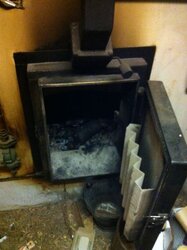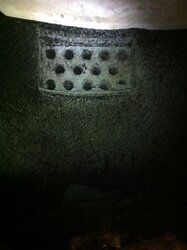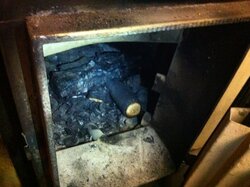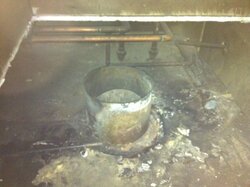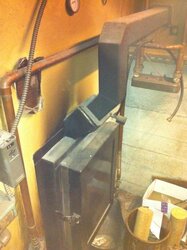First off thank you for any assistance, I inherited this wood boiler setup upon moving to Idaho and my goal is to get it solid and reliable and eliminate the finicky issues and smoke-out.
I have a wood fired boiler with about 15 2" x three feet long fire tubes before the smoke exhausts out the stack. The fire box is approximately 30 gallons in size. The boiler has a constant draft fan supplying air. The air pushes past a damper that has an attached weight that closes when the fan shuts off.
The boiler has a straight 8" single pipe coming out the back of the unit. There was a 30 degree bend selkirk metalbestos pipe simply slid onto the top of this pipe. The flue continued about 9 vertical feet of connected metalbestos pipe out the roof. Some of the seams were taped but I noticed two 30 degree sections upon disassembly have deteriorated and need replacing.
My first problem is that if the fire got too hot, adding a couple pine logs or too much larch bark or too much wood in general, the damper prior to the firebox would start flapping wildly and the seams of the flue pipe would smoke out the attic. This leads to my second problem that I can't fill the fire box as much as I'd like so I end up feeding it once an hour or so and this will gain about ten degrees water temp on the boiler per hour.
I'm figuring I need a 258240 adapter to properly connect the boiler to the selkirk pipe. I'm also intending to replace the corroding 30's and seal every joint with silicone and tape as I work my way back up the chimney. I was concerned that I would need a positive pressure pipe such as ICC Vip+ but upon contacting ICC they said their pipe is not certified for solid fuel. Upon further research I became optimistic that simply reassembling new pipe with the proper adapter would be a permanent solution.
So this is my first experience with a boiler and flue pipe and I would very much appreciate any feedback if my plan is solid or if I'm overlooking anything and I will need to run on propane backup all winter(not ideal). The Selkirk does not list positive pressure and that was my main concern although I don't think I'm dealing with much pressure at all.
Thanks a bunch
I have a wood fired boiler with about 15 2" x three feet long fire tubes before the smoke exhausts out the stack. The fire box is approximately 30 gallons in size. The boiler has a constant draft fan supplying air. The air pushes past a damper that has an attached weight that closes when the fan shuts off.
The boiler has a straight 8" single pipe coming out the back of the unit. There was a 30 degree bend selkirk metalbestos pipe simply slid onto the top of this pipe. The flue continued about 9 vertical feet of connected metalbestos pipe out the roof. Some of the seams were taped but I noticed two 30 degree sections upon disassembly have deteriorated and need replacing.
My first problem is that if the fire got too hot, adding a couple pine logs or too much larch bark or too much wood in general, the damper prior to the firebox would start flapping wildly and the seams of the flue pipe would smoke out the attic. This leads to my second problem that I can't fill the fire box as much as I'd like so I end up feeding it once an hour or so and this will gain about ten degrees water temp on the boiler per hour.
I'm figuring I need a 258240 adapter to properly connect the boiler to the selkirk pipe. I'm also intending to replace the corroding 30's and seal every joint with silicone and tape as I work my way back up the chimney. I was concerned that I would need a positive pressure pipe such as ICC Vip+ but upon contacting ICC they said their pipe is not certified for solid fuel. Upon further research I became optimistic that simply reassembling new pipe with the proper adapter would be a permanent solution.
So this is my first experience with a boiler and flue pipe and I would very much appreciate any feedback if my plan is solid or if I'm overlooking anything and I will need to run on propane backup all winter(not ideal). The Selkirk does not list positive pressure and that was my main concern although I don't think I'm dealing with much pressure at all.
Thanks a bunch


